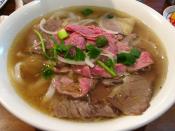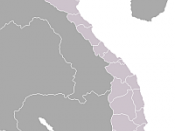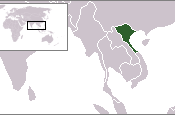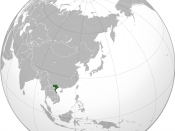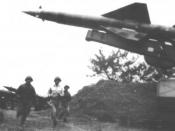ÃÂDonÃÂt you understand, Little One?ÃÂ Second Harvest said gesturing towards the creek and the house, ÃÂThis is all we wanted.ÃÂ (Borton 132).
The American military came to Vietnam with intentions to stop Communist expansion, at the eventual expense of millions of lives. However, spreading Communism was not always the goal of Vietnamese resistance to American troops. Instead, most of those in opposition to the U.S. were fighting for the right to live peacefully, and for the safety of their families. These non-ideological motives were overlooked by the U.S. and contributed greatly to North VietnamÃÂs victory as demonstrated through the testimony of Vietnamese women, and through the reforms of the Renovation.
The wars the U.S. had fought before Vietnam almost never used women as troops or spies. Consequently, along with the notion that it is generally considered cruel to kill women in war, the U.S. military barely even considered the possibility of fighting against Vietnamese women. Forced to endure decades of oppression and fighting, the women felt they ÃÂhad to rise upÃÂ (Borton 76) in an effort to bring about peace and stability. During the French conflict, ÃÂSouthern women captured three districts in Ben Tre provinceÃÂ (Borton 112- 113). After all, a life in a country full of starvation and war was not ÃÂthe life [they] wanted for [their] childrenÃÂ (Borton 110). Acting as ÃÂguidesÃÂ and ÃÂspiesÃÂ (Borton 118), women managed to ÃÂmemorize messages, carry maps, [and] gather intelligenceÃÂ (Borton 112) under the noses of American troops. If ever questioned by American GIs, the women would ÃÂanswer ÃÂI didnÃÂt see,ÃÂ ÃÂI didnÃÂt hear,ÃÂ ÃÂI donÃÂt know,ÃÂÃÂ (Borton 118). Some, such as Second Harvest in After Sorrow, ÃÂcarried a rifleÃÂ (Borton 98). Autumn, also from After Sorrow, claims that ÃÂWomen rarely ratted under torture; the men were more likely to squealÃÂ (Borton 83). The desperate actions of these noble women illustrate how the Vietnamese were fighting for peace and stability, not just for a Communist government. Because ÃÂthe Americans never did understand the power of womenÃÂ (Borton 78) or their motives, incredible strain was placed upon the U.S. troops which contributed to North VietnamÃÂs victory.
In the mid 1980s, the government of Vietnam underwent changes in many fields to make Vietnam a more prosperous and civilized nation. One of these major changes included shifting from a centrally controlled economy where citizens were ÃÂdiscouraged from making and selling goods privatelyÃÂ (Borton 216), to a market based economy- a staple of robust Western nations. When the Vietnamese ÃÂgovernment called for more opennessÃÂ (Victoria 34), more money came into the hands of Vietnamese peasants who bought ÃÂelectric fans, cassette recorders, TVs, [and] refrigeratorsÃÂ (Borton 199). Indeed, if ÃÂmaterial goods are to be a gauge, almost every household in Khanh Phu [village] seemed better off than in late 1990ÃÂ (Borton 236).The renovation also allowed ÃÂmore freedom of movementÃÂ within and without the country for foreigners. In 1994, the U.S.A finally lifted its ÃÂeconomic embargo which had been in place since the 1960sÃÂ (Facts aboutÃÂ 35), allowing Vietnam to obtain loans and do business with U.S. companies. Because the country of Vietnam embraced this new economy, one can infer that the motives of Anti-American Vietnamese two decades before were not just to spread communism. Since the wartime American military and government failed to view the Vietnamese as anything except martyrs of communism, they never established a true connection to the people - a vital component towards winning the war. Consequently, this lack of connection contributed to North VietnamÃÂs victory.
I chose to write about this lack of understanding because I believe most Americans to this day believe the Vietnamese were fighting only to spread communism. This belief is founded in our high-school history courses, where we are taught that America entered Vietnam to stop the spread of Communism. Because we only consider the American side in these history courses, we are left with this close-minded notion that the Vietnamese were only fighting for communism. Although it seems obvious in hindsight that not all Vietnamese were fighting for Communism, books like After Sorrow are essential to open the minds of Americans and increase the understanding on the conflict. This lesson to not stereotype the people fighting against us can be applied today with the American war in Iraq. Like the Vietnamese conflict 30 years before, there is a major lack of understanding residing in the minds of the American people when it comes to the Iraqi people. Too many people regard this diverse civilization as primitive and terrorists fighting to destroy America. Hopefully, it wonÃÂt take a book twenty years from now for the public to sympathize and understand the Iraqi people.
Works CitedÃÂFacts about Vietnam - HistoryÃÂ Vietnam, Victoria, Australia: Lonely Planet publications, 1999, pp. 11, 19-35After Sorrow - An American Among The Vietnamese, Lady Borton, New York, New York, Kondasha International Publications
